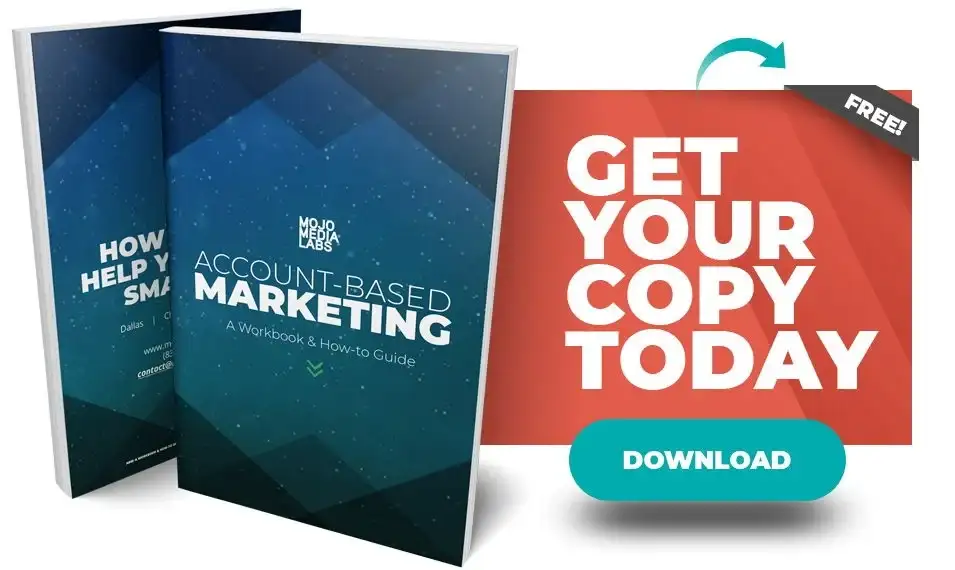How to Create and Use Your Target Account List for Account-Based Marketing
You've decided you are ready to use the account-based marketing (ABM) method as your main marketing strategy and approach. If you are in the business-to-business (B2B) space, this is likely an incredibly wise decision.
Congrats! You are one step closer to achieving world domination or whatever goal you have set your eyes on!
With account-based marketing as the way forward, you know you need to create your list of target accounts. As you start to create your list, you realize there are hundreds of thousands of ways you can go about creating this list.
You want to use your time efficiently, so now you are reading this blog. So let's get to work.

The Quick Checklist
- Create an Ideal Customer Profile: Look at your current customers. Which ones do you love working with? Identify the trends between your favorite accounts. Write the trends down. You created an Ideal Customer Profile.
- Create a Target List based on your Ideal Customer Profile: Find more companies like the current companies you love working with.
- Understand the Accounts on the list: Assess how likely each account is to buy from you. Even though every company is a good fit, they probably aren't all likely to close quickly.
- Create a tiered approach: Now that you have assessed the likelihood of an account closing, focus your efforts on the accounts you see will close more quickly.
- Align your Team: You now have a detailed list of accounts you are targeting. Make sure everyone understands their responsibilities, then go close some deals.
Need help implementing ABM? We can help. Schedule a call today.
Create an Ideal Customer Profile
You likely already have customers. The easiest way to create an ideal customer profile (ICP) is to look at your existing customers. To get started with creating an ICP, there are a few conversations that need to take place.
- Speak to your finance department: One of the major benefits of ABM is a dramatic increase in ROI. The increase in ROI results from marketing specifically to companies that will result in higher profitability. When you go to your finance department, they should tell you which clients don't just bring in the most revenue but are the most profitable clients overall.
- Speak with your customer support: When you are well matched to the customer, they typically need less support. When they do need help, they are generally nice about it. What your support department can offer you is a list of clients that are pleasant to work with. They can also give you a list of clients that aren't as pleasant to work with.
- Speak to your sales team: For ABM to work effectively, marketing and sales must be aligned. Save this conversation for last because this conversation will become an ongoing one. Your sales team knows which customers were such a good fit that they sold themselves. You want to target customers where your product or service makes so much sense, they start to sell themselves.
Once you have these lists from these departments, start to identify some trends. A few questions you can ask yourself are:
- How many employees do our best customers have?
- What is the average annual revenue of our best customers?
- Who is typically the main point of contact?
- How many years have they been in business?
- What industry do they serve?
- Do they have established specific departments?
- What stage of business development are they in?
- What technology are they using?
- How long have they been partnering with us?
- Were they using a specific product or service before partnering with us?
There are numerous additional questions you could ask that will pertain specifically to your business or industry. Just ensure the questions you ask are analyzing for potential trends.
Once you have a list of significant trends based on your existing customers, create a list of positive and negative attributes for potential customers. Now you have a framework to measure against as you look to create your list.
Important Note: Your ICP should be used as a guideline, not a hard and fast checklist.
You know the more closely a potential customer reflects your ICP, the more likely they are to be a great fit. Don't automatically disqualify a potential customer because they don't perfectly match the ICP.
It's called an ideal customer profile. Not every customer will fit exactly, and that's normal.
Create Your Target List of Accounts Based on Your Ideal Customer Profile
Now that you have a list of positive and negative attributes for your ideal customer, you need to create a list of target customers that fit this list.
Creating a list of target customers is far more difficult than creating a list of fantastic clients. With the previous list, you really just filtered. With this list, you are creating something from nothing.
There are a few ways to start creating your target account lists.
- Ask your sales team: As previously mentioned, you will start becoming best friends with your sales team. They likely have had their eyes on potential customers they would love to see close.
This approach to creating the list works especially well because you are more likely to get alignment and buy-in from everyone. When you ask your sales team who they want to close, then provide them with a meeting, they are more likely to buy into the new approach. - Google it: This sounds sarcastic. It's not. There is a top ten list for just about everything. Just Google the top companies in your industry. You can also start by Googling the characteristics related to your ICP and see what comes up.
- Local Business Organizations: If you are a B2B company trying to serve your local community, go to your local Better Business Bureau, chamber of commerce, rotary club, or other local business organization. They will provide you with the basic information you need to get started.
- LinkedIn: The free version of LinkedIn has a wide variety of filtering options you can use to identify some potential target companies. You have options to filter by location, company size, industry, and a variety of other filters.
Should you use Sales Navigator, your filtering options are far more advanced and targeted. Though you can't directly export lists from LinkedIn Sales Navigator, you can integrate with various CRMs (including HubSpot and Salesforce) and start nurturing your target accounts from there. - ABM Technology: The previously mentioned approaches are mostly free, but as a result are far more labor-intensive. For incredibly effective ABM, you need access to an abundance of high-quality and accurate data. If you want to run ABM campaigns designed to deliver ridiculous results, you should consider technology partners like Terminus, SalesIntel, or ZoomInfo.
These partners allow you to put in your ideal customer profile to then generate a list only matching those specific criteria. Then you can export the information and reach out directly to the most relevant point of contact at each of these target accounts.
If you are interested in exploring how to integrate ABM technology into your ABM strategy, check out our ABM tech stack workbook.
After assessing which approach makes the most sense for your business, it's time to create your list. As you start to create this list, you may find yourself either creating a list too ridiculously small or creating a list too impossibly large.
If you have a list with too few target accounts, you need to either adjust your ICP to have some broader criteria, or you need to prioritize your criteria better. You may say that target accounts must meet three pieces of your ICP instead of five.
If you have created a list too large, return to your ICP, and make a few criteria non-negotiable. This may feel like you are excluding potential customers and revenue opportunities, and in reality, you are. You are making the strategic decision to stop chasing every potential opportunity and to start focusing on that opportunity most profitable and likely to close.
Also, don't forget that anyone can come to your website and request a form. You are not saying you refuse to do business with anyone that doesn't end up as a top priority on your target account list. You are simply choosing to spend your time focusing on a few "best-fit" opportunities instead of a lot of potential "good-fit" opportunities.
The size of your list will dramatically vary depending on your industry, technology, and number of salespeople. A good rule of thumb for the number of target accounts would be 500-750 accounts per salesperson. If you have five salespeople, and marketing is nurturing 2,500 accounts, you will likely be able to deliver sustainable meetings at a consistent rate as not to overwhelm your sales team.
Understand the Accounts on your list
Now that you have a list of ideal potential customers, you need to start gathering more information regarding their intent and likelihood of purchasing your product soon.
To effectively understand these target accounts you need to understand the account as a whole and the contacts within the account.
The questions outlined below are a good starting point if you don't have the budget to invest in ABM technology. With the right technology in place, you can start to sort and filter your lists based on advanced algorithms that evaluate someone's intent to purchase a certain kind of product or service.
If you don't have the budget for ABM technology, we don't recommend walking every account on your list through this process. Many times lists get up into the thousands and manually walking through this process would take far longer than is realistic. We would recommend starting small with somewhere between 15 and 30 accounts.
Some questions to explore so you can better understand the account are:
- What product or service are they currently using that I would need to beat?
- Have they recently won any awards?
- Have they recently acquired any companies?
- Have they recently started a hiring blitz?
- Have they recently undergone a layoff?
- Have they recently had a major fluctuation in their revenue?
- Have they recently had any significant shift in their customer base?
- Have they recently hired any new executives, VP's or Directors?
- What do their budget and fiscal year look like?
These are some questions that will help you to better understand if they are likely to purchase your products or services.
To also clarify, there isn't a right or wrong answer to these questions. These questions provide you the context to know if your offer will fit that company at this time.
A mass layoff may indicate to a software company they need better technology to streamline their processes and get the same output from fewer employees. A hiring blitz may indicate to headhunting services that this company clearly needs more employees.
Neither is inherently positive or negative for your solutions. It's just contextual.
After you have assessed the account, you then need to determine the specific contacts within the accounts. Though you are selling to a business, you need to understand who you need to speak with to know if the company is still a good fit.
Some questions you may want to consider regarding contacts of the account are:
- Who would most benefit from partnering with us?
- What are their responsibilities to their company?
- Who would become an internal advocate for us?
- Where do they fall in the organization structure?
- Who is the decision-maker?
- Are the contacts open to change?
- Do the contacts have specific grievances regarding their current solution or lack of a solution?
- Who would become the main point of contact?
Unlike the questions regarding the accounts, there is a right and wrong answer to these questions. The more positive answers you can get here, the more likely you are to get a deal.
Important Note: The answers to these questions aren't final. Accounts are ever-evolving. Continually check back with these questions, and adjust where you prioritize your time accordingly.
Create a Tiered Approach
Now that you have walked through the questions above or have used ABM software to assess the potential intent to buy of each account, you need to create a tiered approach to engaging these accounts.
This sounds far more complicated than it is. Many companies use a three-tiered approach with their ABM.
- Top Tier: Based on the list's size and the number of salespeople you have, take the top 10% to 20% of your list. This tier will require the vast majority of your marketing and sales efforts. These accounts are accounts that would see major success from your offer and have shown significant potential to close quickly. These become your success stories and case studies.
You want to create hyper-personalized and specific marketing collateral to attract and engage these potential customers into sales conversations. Then you want to equip your sales team with the material they need to move the sales process forward towards a won deal.
This tier is receiving frequent direct and targeted outreach from marketing and sales with the express intent of closing new business quickly. - Mid Tier: This tier will likely consist makeup 20% to 30% of your list. This tier consists of accounts that have shown the potential to close at some point in the next 12 months. You want to create and provide highly relevant marketing material for this tier.
The accounts are likely conducting high-level research regarding your product or service. The purpose of the marketing in this tier is to educate and shape the way the contacts think about the products or services offered by you and your competitors.
This tier receives consistent, relevant information from marketing and sales with the intent to maintain relevance to the buyer and ramp them up towards starting a formal sales conversation. The relationship should work on a general advisor level to build trust. - Bottom Tier: This tier will likely consist of 50% to 70% of your list. These accounts would benefit from your product or service, and match your ICP, but don't presently have the intent to buy.
The accounts in this tier may not know much about your product or service or realize they face a problem. The goal for accounts in this tier is to prompt engagement. You want the accounts in this tier to know who you are, and start engaging with you at any level. This could be something as simple as subscribing to your weekly newsletter.
Once you have started to see consistent engagement from a bottom-tier account, there is a higher likelihood they are starting to research more about your product or service. At this point, the account would move to a mid-tier account and your marketing and sales team would start to engage in more frequent conversations.
Align Your Marketing and Sales Teams
Now that you have a targeted list broken out into specific tiers, it's time to execute. You have dedicated a lot of time to create a list of accounts. As you align your marketing and sales teams, each should have specific responsibilities they are held accountable for. These responsibilities can be whatever you and your teams decide.
Below are some recommendations as to the appropriate responsibilities for each department.
Marketing should:
- Deliver a set number of meetings or interesting accounts weekly
- Create opportunities for engagement for each tier
- Create specific marketing content to enable the sales team to move the sales process forward
- Check-in with sales to assess and adjust the target list
Sales should:
- Meet with the accounts delivered by marketing
- Consistently conduct outreach to accounts in each tier to move them closer to closing
- Promote opportunities for engagement created by marketing
- Help marketing know what content would best enable the sales process
- Check-in with marketing to assess and adjust the target list
You know your organization would experience massive growth if your marketing and sales efforts aligned around the same goal of closing targeted accounts. All you need to do is set a goal, assign responsibilities everyone agrees to, then hold each other accountable.
Time to Close Some New Accounts
With your list in hand and your teams aligned, you are off to a great start. Now all you have to do is close your first deal and you will have gathered buy-in across the board.
If you'd like an experienced ABM partner to help you implement an effective ABM strategy, schedule a call today. Our growth consultant to talk through how we can partner with you to implement an ABM strategy and align your marketing with your sales.



